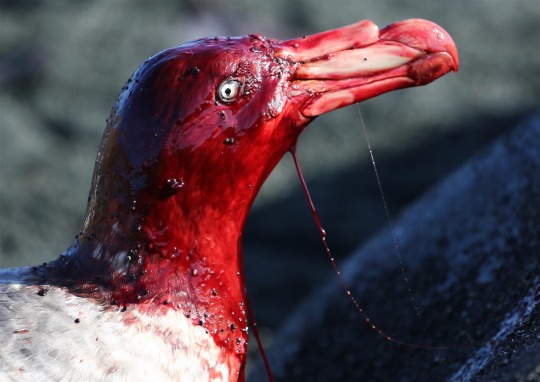#Giant Petrel
Text


Relatively brief post because I imagine people won't care much about this one (nor is there that much to talk about). But newly described from the Pliocene of New Zealand we have Macronectes tinae, which we might as well call Tina's Giant Petrel.
Known from a really well preserved skull and a partial humerus, Tina's Giant Petrel is a species of giant petrel, but notably smaller and less robust than the modern species, like these ones.

There might be two reasons why its smaller. One is simple really. Giant petrels stand out amongst their relatives for being ridiculously big, while all their closest kin are pretty small. So logically, an older, more basal giant petrel is expected to be smaller. The authors also speculate that living in warmer waters is another factor, but modern petrel ranges are huge so that hypothesis is less solid.
Even if it was smaller, Tina's Giant Petrel still lived a life that was likely similar to its modern relatives. Meaning it was an absolute beast of a bird. Modern petrels are well known to scavenge near seal colonies and penguing colonies, mob other birds, steal and eat the chicks of other sea birds and also hunt for fish, squid and crustaceans. Google "giant petrel" and expect to be greeted by birds either absolutely tearing apart carcasses or being covered in blood. Petrels look pretty metal. As it so happens, Tina's Giant Petrel was found in a formation that is in no short supply of potential prey.
Eomonachus, a monk seal (illustrated by seal king Jaime Bran), Eudyptes atatu, a penguin (illustrated by Simone Giovanardi), Aldiomedes angustirostris, an albatross, various petrels and an undescribed species of pseudo-tooth bird (skull illustration by Jaime Headden) all would have given the extinct petrel a lot of options.


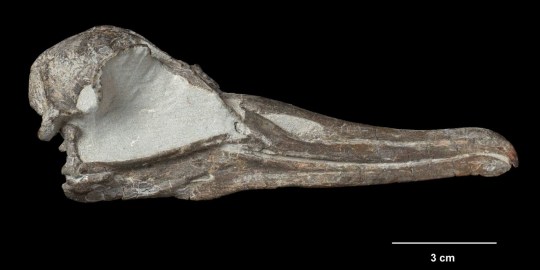
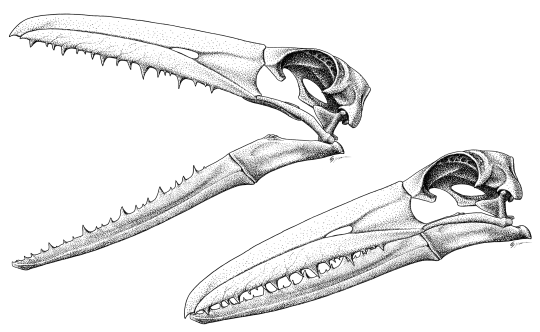
The paper also provides an illustration of the bird itself. Notably the artist, Simone Giovanardi who previously illustrated the penguins up above, decided to give this species darker plumage, reasoning that petrels in warmer waters tend to be darker than their relatives in the colder waters further south. The illustration shows it feeding on the carcass of a seal, probably the local Eomonachus.

Link to the paper: Taxonomy | Free Full-Text | A New Giant Petrel (Macronectes, Aves: Procellariidae) from the Pliocene of Taranaki, New Zealand (mdpi.com)
And obligatory link to Wikipedia: Macronectes tinae - Wikipedia
#giant petrel#paleontology#macronectes tinae#seabird#new zealand#palaeblr#technically dinosaur#bird#petrel#extinct bird#pliocene#Tangahoe Formation
55 notes
·
View notes
Text
BRACKET A
Bare-Throated Bellbird (Procnias nudicollis)
Jesus fucking christ
VERSUS
Giant Petrel (genus Macronectes)
They’re very violent hyper aggressive predatory birds that will kill a seal and dance on its dead body (this is called sealmaster posture) to show everybody else that nobody can do what this bird can do. They love to batter and drown other birds to death—including albatrosses! They’re often dyed red with the blood of their enemies. There is something wrong with them.

40 notes
·
View notes
Photo

Horu Terror-Petrel, one bad-tempered bird
#Character Design#traditional art#giant petrel#bird character#weapon design#battle axe#fantasy art#anthropomorphic
16 notes
·
View notes
Text

aheehee
21 notes
·
View notes
Text
"Antarctic Terror"
2022

Southern Giant Petrel (Macronectes giganteus)
A very bloody Giant Petrel. One of the most intimidating birds in the world, I think.
#giant petrel#procellariiformes#birds#animals#animal art#wildlife#wildlife art#photoshop#art#artists on tumblr#mexican artist#autistic artist#dartxo
2 notes
·
View notes
Text
Animal of the Day!
Southern Giant Petrel (Macronectes giganteus)

(Photo by Brian Sullivan)
Conservation Status- Least Concern
Habitat- Antarctica; Africa; Australia; Chile
Size (Weight/Length)- 99 cm; 205 cm wingspan
Diet- Squid; Krill; Carrion; Penguins; Seals
Cool Facts- Southern giant petrels are possibly the most malicious birds in the history of ever. While mostly eating squid and fish, they will not turn their beak up at a helpless seal pup or penguin. Graphic warning, the animals are often eaten alive. Yeah, nature isn’t always pretty. They are also known for holding down smaller birds like black-browed albatross and gannets underwater to drown them. Despite the horrors, Southern giant petrels are monogamous and are extremely protective of their chicks.
Rating- 9/10 (They’re called stinkers too.)
#Animal of the day#Animals#Birds#Sea birds#Tuesday#August 23#Southern giant petrel#Giant petrel#Fulmar#biology#science#conservation#the more you know
39 notes
·
View notes
Note
TOP FIVE: Apex Predators
Woohoohoo thank you for the ask! (Fun fact: I wanted to be a zoologist as a kid! Although I don’t want to do that anymore, I still love animals, so this ask delighted me.)
First has to be the great white shark. I love sharks and had many books about them as a kid. They strike much fear into me but in the best way possible. I have so much respect for this majestic marine beast.
The crocodile comes in second bc it is the predator of the hippo. I don’t hate hippos, I just hate that they can get away with murder just bc people think they look cute. Crocodiles put hippos in their place, and for that I’ve got to stan.
The Tasmanian Devil! I learned about these guys in an episode of Wild Kratts as a kid and have been in love ever since. They guys are cute, but they could rip you to shreds and it’s great. I love my widdle murder puppers!
Giant Petrel. I love birds, so I gotta have a bird on this list. And I can get behind some bird on bird violence, their bloodlust is part of the reason I like birds so much.
Finally, I had to decide between the tiger and the snow leopard. I decided by thinking of Tigress vs Tai Lung from King Fu Panda. I know Tai Lung beat Tigress, but I still love my kung fu girl boss more, so tiger wins! Plus they are so beautiful, ok! One of my favorite animal prints.
Thank you so much for the ask! This was a blast!
#my cool mutual#ask game#ask for moi#nerd out#nerd-out#animals#great white shark#crocodile#tasmanian devil#giant petrel#tiger#snow leopard
1 note
·
View note
Text
Antarctica Dream Expedition 7 - Fortuna Bay
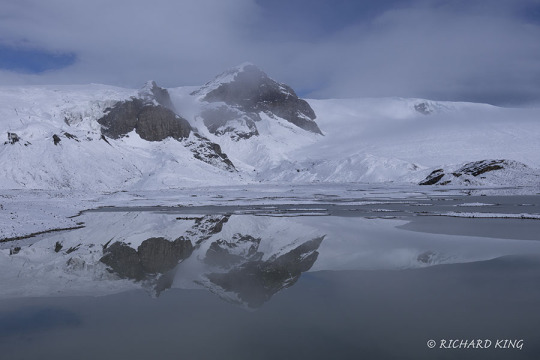
View On WordPress
#Antarctica#Chionisalba#NikkorZ100-400mm#NikonCreators#NikonLove#NikonZ8#Snowysheathbill#SouthGeorgia#Antarctica Dream Adventure#Antarctica Expedition#British Overseas Territory#Chionis albus#early light#elephant seal#Fortuna Bay#Fur Seals#Gentoo Penguin#Giant Petrel#glaciers#King Penguin#King penguin mating ritual#Mist#Mountains#Nikkor 24-70mm f/4 S#Nikkor Z 100-400mm f/4.5-5.6 VR S#Nikkor Z TC-1.4x#Nikon Z 8#reflections#Richard King Photography#Snowy SHeathbill
1 note
·
View note
Text

A pair of Northern giant petrels (Macronectes halli) in Elsehul Bay, South Georgia
by Gregory "Slobirdr" Smith
#northern giant petrel#petrels#seabirds#birds#macronectes halli#macronectes#procellariidae#procellariiformes#aves#chordata#wildlife: south georgia islands#wildlife: antarctica
102 notes
·
View notes
Text
damn i love frigatebirds!!! they have such cool silhouettes, with their long wings and forked tails, and they have an exquisite glossy sheen on their back feathers....give my compliments to evolution, she really knows how to make a good bird
they have reputations for being pirates, and are very agile considering their size! however food stealing is only a supplement and doesn't usually form a large part of their diet. they have a particular taste for flying fish!
frigates also sleep on the wing and can also go up to 4000 ft high if need be which i think is insane! raising a chick takes so long that they mostly just breed every other year. also two species, christmas island and ascension island frigatebirds, only breed on one small island each - those two species are also endangered :((
#contact call#saw a stupid youtube comment a while back calling them evil and i'm still mad about it so i made this post lol#i am the world's biggest defender of hated seabirds (gulls / skuas / frigatebirds / giant petrels)
1 note
·
View note
Text
SEMIFINALS
Hoatzin (Opisthocomus hoazin)
Their chicks have little fingers and claws on their wings for climbing. Also, they produce bacteria in their weird enlarged crops that are ONLY found in there. Their crops are so big that they don’t really fly. They smell like manure. They’re like if cows were birds if cows had claws and were super colorful.
VERSUS
Giant Petrel (genus Macronectes)
They’re very violent hyper aggressive predatory birds that will kill a seal and dance on its dead body (this is called sealmaster posture) to show everybody else that nobody can do what this bird can do. They love to batter and drown other birds to death—including albatrosses! They’re often dyed red with the blood of their enemies.

26 notes
·
View notes
Text
this is a giant petrel hate blog
2 notes
·
View notes
Photo
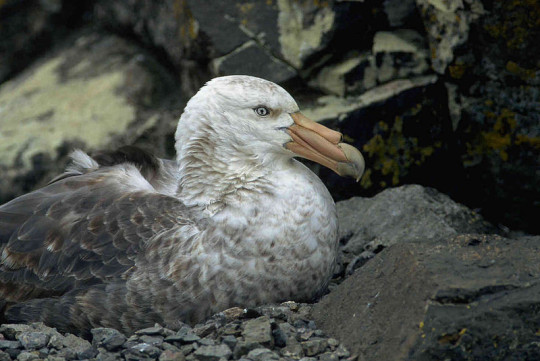
A new variant has been added!
Southern Giant Petrel (Macronectes giganteus)
© Gregory 'Slobirdr' Smith
It hatches from big, black, common, dark, diagnostic, greenish, large, overall, pale, scarce, southern, white, whitish, and widespread eggs.
squawkoverflow - the ultimate bird collecting game
🥚 hatch ❤️ collect 🤝 connect
1 note
·
View note
Note
I’m currently foaming at the mouth for some Karou Emperor Penguin Harpy x Adelie Penguin Harpy Reader Headcannons (I watched that video and it was absolutely cute, especially the babies, I love baby animals 🥹🥰)
Please feed us Seymour (If you don’t get that reference, it’s 1986 Little Shop of Horrors)
I’m currently giggling and kicking my feet thinking about Child Kaoru as a Baby Penguin 🤭
I feel like my harpy (and fantasy Au’s in general) fascinates the masses. So I can write them real quick.
Yandere Baki Head Canon
Hanayama Kaoru x Older! Reader (Harpy AU)

……………………………………….
Emperor Penguin Hanayama
He was a foolish young chick. He wandered off a lot and picked fights with other penguins since he was much larger than the others, which left him to be respected and feared among his peers
A shame he thought he could take on a giant petrel alone. The older harpy left him covered in deep wounds and probably would have ended his life if you hadn’t appeared… a small Adélie penguin. You fearlessly threw your small body between the petrel and him, which in turn made the petrel flee (no harpy in these frozen wastelands would take on an adelie)
When you turned to check on him, it’s the first time Kaoru ever felt his heart flutter. You were his savior… his future mate. You must care about him if you stepped in to save his life!
Hanayama revels in your care as you assist him back to his colony. He snuggles his body close to yours as you usher him back. He is practically glued to your side
Hanayama won’t let a single penguin insult you for your arrival. Nor will he let anyone try to take you as their mate. He’s decided you’re going to be his
Hanayama chases away all competition and he’s even willing to fight to stay by your side. He doesn’t care that he’s younger. He doesn’t care that you don’t see him as more than just a little sibling, he won’t mate unless it’s with you
The older he gets, there’s no questioning how massive he is compared to the others. He’s intimidating with his various scars. Some from the petrel and others from various battles he’s been in (such as fighting off a rival colony that killed his father). Hanayama is not to be trifled with
And he forced you to stay in his colony with his own power and the various members of his colony. You’re referred to as “the boss’s wife.”
Expect to be dazzled with various pebbles and shells. Hanayama hunts the biggest fish for you and he’s made you the most brilliant of nests. He only collects the very best for you. The size difference doesn’t matter to him
You’re at a point in your life where you know you need to mate or you’ll end up without chicks… so you have no choice but to accept Hanayama’s overbearing affection. He’s practically over the moon when you say yes
Expect him to be with you as much as he physically can. He will be the very best mate and he would never leave you for another… after all, he knows adelies mate for life
#baki the grappler#baki hanma#baki son of ogre#baki x reader#baki the grappler x reader#yandere baki#yandere fic#yandere imagine#yandere#female reader#baki dou#baki headcanons#grappler baki#baki#baki kaoru hanayama#kaoru hanayama#baki AU#fantasy AU#harpy AU#Yandere harpy#bakithegrappler#male reader#yandere hanayama kaoru#hanayama kaoru#hanayama kaoru x reader#possessive yandere#delusional yandere
180 notes
·
View notes
Text
I would like to offer this resource for therians, an extensive list of all of Sir David Attenborough’s nature documentaries that are available on soap2day, and a full list of what species* they each (notably, prominently) feature the natural behaviors of, separated by episode, and omitting species that were only shown dead, juvenile or being predated on. This took me a while (I have been working on it since Prehistoric Planet’s release) because I did in fact have to watch every single series in full in order to list all the species and the episodes are around 50 minutes long, but enjoy.
Long post ahead:
Most of these shows have closed captioning, which is why I’ve picked soap2day. Planet Earth is the only one that doesn’t. I did not include Dynasties and Dynasties II because each episode only features one species.
Thank you to Birch (@ambiguousmutt) for his help (he watched about half of the episodes) so I didn’t have to do it individually. Credit goes to him as well.
*Sometimes Attenborough doesn’t say the specific species and I was too busy trying to get through the episodes to identify it. In those cases I just put the most specific name I could.
Planet Earth
Episode one (From Pole to Pole): emperor penguin, polar bear, caribou, arctic grey wolf, Amur leopard, six-plumed bird-of-paradise, superb bird-of-paradise, great white shark, African elephant, African buffalo, lechwe, baboon, African wild dog
Episode two (Mountains): gelada, walia ibex, Ethiopian wolf, guanaco, cougar, grizzly bear, markhor, snow leopard, golden eagle, grey wolf, panda, golden snub-nosed monkey, red panda, demoiselle crane
Episode three (Fresh Water): giant salamander, grizzly bear, smooth-coated otter, Nile crocodile, dolphin fish, midge, Amazon river dolphin, dorado, piranha, spectacled caiman, crab-eating macaque, snow goose
Episode four (Caves): wrinkle-lipped free-tailed bat, cockroach, bat hawk, cave swiftlet, yellow-red rat snake, Texas blind salamander
Episode five (Deserts): Bactrian camel, dromedary camel, red kangaroo, fennec fox, guanaco, long-nosed bat, Nubian ibex, flat lizard, lion, African elephant, locust
Episode six (Ice Worlds): snow petrel, Antarctic petrel, south polar skua, humpback whale, emperor penguin, eider, muskox, arctic grey wolf, polar bear, little auk, arctic fox
Episode seven (Great Plains): Mongolian gazelle, red-billed quelea, wildebeest, snow goose, arctic fox, arctic grey wolf, bison, wild ass, Tibetan fox, pygmy hog, African elephant, lion, baboon
Episode eight (Jungles): magnificent bird-of-paradise, spider monkey, howler monkey, siamang gibbon, gliding tree frog, colugo, red crab spider, African elephant, chimpanzee
Episode nine (The Shallow Seas): humpback whale, multiple corals, banded sea krait, trevally, dugong, bottlenose dolphin, Socotra cormorant, salp, comb jelly, sea lion, dusky dolphin, sea urchin, sunflower starfish, short-tailed stingray, great white shark, king penguin, fur seal
Episode ten (Seasonal Forests): Eurasian lynx, moose, crossbill, wolverine, western capercaillie, pine marten, great grey owl, pudu, kodkod, mandarin duck, cicada, red deer, Amur leopard, tiger, mouse lemur
Episode eleven (Ocean Deep): whale shark, oceanic whitetip shark, common dolphin, Cory's shearwater, manta ray, sea spider, vampire squid, spider crab, unnamed deep sea eel, giant isopod, chambered nautilus, Pacific spotted dolphin, mola mola, frigatebird, sailfish, blue whale
Planet Earth II
Episode one (Islands): pygmy three-toed sloth, Komodo dragon, sifaka, marine iguana, Galapagos racer, Buller's albatross, fairy tern, Christmas Island red crab, yellow crazy ant, chinstrap penguin
Episode two (Mountains): Nubian ibex, red fox, golden eagle, grizzly bear, bobcat, flamingo, mountain viscacha rat, snow leopard
Episode three (Jungles): spider monkey, flying lizard, sword-billed hummingbird, river dolphin, jaguar, glass frog, paper wasp, click beetle, red bird of paradise, Wilson's bird of paradise, indri
Episode four (Deserts): lion, Harris's hawk, shrike, locust, sand grouse, pale chanting goshawk, feral mustang, golden mole, desert long-eared bat, darkling beetle, Namaqua chameleon
Episode five (Grasslands): saiga antelope, lion, harvest mouse, carmine bee-eater, Kori bustard, African elephant, serval, Jackson's widowbird, grasscutter ant, compass termite, giant anteater, bison, red fox, arctic grey wolf
Episode six (Cities): langur, peregrine falcon, leopard, European starling, great bowerbird, raccoon, rhesus macaque, spotted hyena, wels catfish
Our Planet
Episode one (One Planet): lesser flamingo, orchid bee, golden-collared manakin, red-capped manakin, blue manakin, cormorant, booby, common dolphin, shearwater, African wild dog, timber wolf
Episode two (Frozen Worlds): gentoo penguin, wandering albatross, narwhal, Pacific walrus, humpback whale, orca, leopard seal, polar bear
Episode three (Jungles): lowland gorilla, forest elephant, black sicklebill, twelve-wired bird-of-paradise, western parotia, mountain treeshrew, Philippine eagle, black spider monkey, leafcutter ant, Sumatra orangutan, velvet worm
Episode four (Coastal Seas): northern fur seal, compass jellyfish, giant trevally, mobula ray, Atlantic stingray, bottlenose dolphin, grey reef shark, whitetip reef shark, sea otter, California sheephead wrasse, Steller's sea lion, bald eagle, humpback whale, Guanay cormorant, Inca tern, Peruvian booby, South American sea lion
Episode five (From Deserts to Grasslands): Socotran cormorant, Arabian leopard, Arabian oryx, African elephant, cheetah, bison, Alcon blue butterfly, saiga, Przewalski's wild horse, tiger
Episode six (The High Seas): blue whale, spinner dolphin, mobula ray, oarfish, anglerfish, bristle worm, giant petrel, black-browed albatross, wandering albatross, bluefin tuna, sea lion, humpback whale
Episode seven (Fresh Water): Australian pelican, torrent duck, grizzly bear, manatee, giant mayfly, common kingfisher, osprey, jaguar, callipterus cichlid, Siamese fighting fish, hippopotamus, lion, African elephant, sandhill crane
Episode eight (Forests): Siberian tiger, bald eagle, rough-skinned newt, great hornbill, African elephant, African wild dog, fossa, gray mouse lemur
A Perfect Planet
Episode one (Volcano): lesser flamingo, marabou stork, Galápagos land iguana, vampire ground finch, Aldabra giant tortoise, North American river otter, coyote, Kamchatka brown bear, wildebeest
Episode two (The Sun): yellow-cheeked gibbon, fig wasp, arctic grey wolf, wood frog, garter snake, arctic fox, Saharan silver ant, golden snub-nosed monkey, sooty shearwater, humpback whales
Episode three (Weather): straw-colored fruit bat, fire ant, Amazonian giant river turtle, desert rain frog, Bactrian camel, Christmas Island red crab, carmine bee-eater, Nile crocodile, African fish eagle, hippopotamus
Episode four (Oceans): common dolphin, marine iguana, flightless cormorant, flamboyant cuttlefish, eider, bottlenose dolphin, lemon shark, manta ray, blacktip reef shark, trevally, rockhopper pengin, Eden's whale
Episode five (Humans): none
Life
Episode one (Challenges of Life): bottlenose dolphins, cheetah, panther chameleon, orca, brown-tufted capuchin, stalk-eyed fly, hippopotamus, Clark's grebe, giant Pacific octopus, strawberry poison-dart frog, leopard seal, orangutan
Episode two (Reptiles and Amphibians): pebble toad, caiman, basilisk, Brazilian pygmy gecko, panther chameleon, Namaqua chameleon, red-sided garter snake, collared iguana, hog-nosed snake, horned lizard, sea krait, African bullfrog, Komodo dragon
Episode three (Mammals): Weddell seal, elephant shrew, aye-aye, caribou, straw-colored fruit bat, lion, spotted hyena, polar bear, brown-nosed coati, meerkat, African elephant, humpback whale
Episode four (Fish): sailfish, flying fish, weedy sea dragon, convict fish, sarcastic fringehead, mudskipper, Hawaiian freshwater goby, hippopotamus, barbel, silvertip shark, clownfish, sea lion, ragged tooth shark, multiple snapper, whale shark
Episode five (Birds): spatuletail hummingbird, lammergeier, red-billed tropicbird, magnificent frigatebird, red knot, horseshoe crab, lesser flamingo, chinstrap penguin, great white pelican, Clark’s grebe, sage grouse, Vogelkop bowerbird
Episode six (Insects): Darwin’s beetle, unnamed damselfly, monarch butterfly, alkali fly, Wilson’s phalarope, oogpister beetle, mongoose, bombardier beetle, honey bee, black bear, Japanese red bug, Dawson’s bee, grass cutter ant
Episode seven (Hunters and Hunted): ibex, short-tailed stoat, brown bear, Ethiopian wolf, California ground squirrel, star-nosed mole, cheetah, red fox, greater bulldog bat, bottlenose dolphin, Bengal tiger, rattlesnake, orca
Episode eight (Creatures of the Deep): Pompeii worm, Humboldt squid, nemertean worm, moon jelly, fried egg jellyfish, spider crab, stingray, cuttlefish, giant Pacific octopus, sunflower sea star, king crab, cleaner shrimp
Episode nine (Plants): monarch butterfly, purple-throated carib hummingbird
Episode ten (Primates): Hamadryas baboon, Japanese macaque, lowland gorilla, spectral tarsier, phayre's leaf monkey, ring-tailed lemur, Sumatra orangutan, chacma baboon, white-faced capuchin, brown-tufted capuchin, western chimpanzee
Blue Planet II
Episode one (One Ocean): bottlenose dolphin, tuskfish, tern, giant trevally, mobula ray, false killer whale, Asian sheepshead wrasse, orca, humpback whale, walrus
Episode two (The Deep): sea toad, Venus’ flower basket, unnamed shrimp, ethereal snailfish, cock-eyed squid, pyrosome, barrel-eyed fish, unnamed siphonophore, yeti crab, Humboldt squid, fangtooth fish, sixgill shark, scabbardfish, zombie worm
Episode three (Coral Reefs): broadclub cuttlefish, coral grouper, day octopus, multiple corals, green turtle, bottlenose dolphin, manta ray, bobbit worm, saddleback clownfish, marbled grouper, grey reef shark
Episode four (Big Blue): spinner dolphin, yellowfin tuna, mobula ray, sailfish, sperm whale, sea turtle, blue shark, great white shark, multiple jellyfish, Portuguese man o' war, whale shark, wandering albatross, shortfin pilot whale
Episode five (Green Seas): Garibaldi, Australian giant cuttlefish, weedy seadragon, common octopus, pyjama shark, sea otter, tiger shark, smooth stingray, zebra mantis shrimp, common dolphin, humpback whale
Episode six (Coasts): Pacific leaping blenny, king penguin, southern elephant seal, Sally Lightfoot crab, Galápagos sea lion, ochre starfish, clingfish, chain moray eel, Atlantic puffin, arctic skua
Episode seven (Our Blue Planet): none
Prehistoric Planet
Episode one (Coasts): Tyrannosaurus rex, Tethydraco, Phosphatodraco, Tuarangisaurus, Mosasaurus hoffmannii, pycnodont fish, ammonites, Kaikaifilu
Episode two (Deserts): Dreadnoughtus, Tarbosaurus, Velociraptor, Mononykus, Barbaridactylus, Secernosaurus
Episode three (Freshwater): Velociraptor, Tyrannosaurus rex, Deinocheirus, Quetzalcoatlus, Masiakasaurus, Beelzebufo, elasmosaur
Episode four (Ice Worlds): dromaeosaur, hadrosaur, Ornithomimus, Olorotitan, troodontid, Antarctopelta, Pachyrhinosaurus, Nanuqsaurus
Episode five (Forests): Austroposeidon, Triceratops, Carnotaurus, Qianzhousaurus, Edmontosaurus, Atrociraptor, Anodontosaurus, Therizinosaurus, Telmatosaurus, Hatzegopteryx
The Hunt
Episode one (The Hardest Challenge): African leopard, African wild dog, Parson’s chameleon, nose-horned chameleon, African mantis, Darwin’s bark spider, Nile crocodile, Amur falcon, orca, cheetah
Episode two (Arctic): polar bear, arctic grey wolf, arctic fox, glaucous gull
Episode three (Forests): tiger, American marten, sparrow hawk, Portia spider, tarsier, harpy eagle, chimpanzee, army ant
Episode four (Oceans): blue whale, frigatebird, dorado, sargassum fish, spinner dolphin, Beroe ovata, Chiroteuthis, lionfish, black-browed albatross, sea lion, tuna, copper shark, common dolphin, Bryde's whale
Episode five (Plains): cheetah, caracal, honey badger, termite, bald eagle, lion, Ethiopian wolf, hotrod ant, spoor spider
Episode six (Coasts): bottlenose dolphin, algae octopus, sand bubbler crab, long-tailed macaque, marine otter, grizzly bear, grey wolf, peregrine falcon, orca, humpback whale
Episode seven (Conservation): none
Life In Colour
Episode one (Seeing In Color): Indian peafowl, mandrill, Costa’s hummingbird, magnificent bird-of-paradise, blue moon butterfly, fiddler crab, mantis shrimp, flamingo, poison dart frog
Episode two (Hiding In Color): Bengal tiger, langur, ptarmigan, crab spider, zebra, Cuban painted snail, blue-striped fangblenny, common waxbill, pin-tailed wydah, Augrabies flat lizard
Frozen Planet II
Episode one (Frozen Worlds): emperor penguin, orca, Pallas’s cat, Siberian tiger, grizzly bear, hooded seal, polar bear
Episode two (Frozen Ocean): polar bear, beluga, harp seal, skeleton shrimp, crested auklet, orca
Episode three (Frozen Peaks): high-casqued chameleon, japanese macaque, kea, andean flamingo, giant panda, golden eagle, andean mountain lion
Episode four (Frozen South): king penguin, Antipodean wandering albatross, blue whale, Weddell seal, chinstrap penguin, snow petrel, leopard seal, orca
Episode five (Frozen Lands): grey wolf, arctic fox, Amur leopard, Siberian tiger, painted turtl, Lapland bumblebee, snowy owl, caribou, grizzly bear
Episode six (Our Frozen Planet): none
Africa
Episode one (Kalahari): fork-tailed drongo, ostrich, black rhinoceros, Angolan giraffe, African leopard, armored ground cricket, spider wasp
Episode two (Savannah): Agama lizard, shoebill, bee-eaters and rollers, lesser flamingo, African elephant, crowned eagle, African fish eagle, martial eagle
Episode three (Congo): chimpanzee, central African rock python, Angola banana frog, African skimmer, rockfowl, African elephant
Episode four (Cape): emperor swallowtail, giant kingfish, African penguin, monkey beetle, springbok, yellow-billed kite, pied crow, ghost crab, vundu catfish, Nile crocodile, Bryde’s whale, great white shark, common dolphin
Episode five (Sahara): Grevy’s zebra, naked mole rat, barn swallow, Dromedary camel, dung beetle, crocodile, western yellow wagtail, Saharan silver ant
Episode six (The Future): none
521 notes
·
View notes
